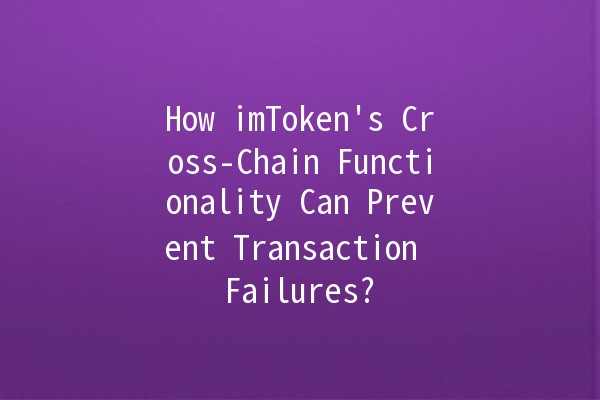In recent years, the rise of blockchain technology has introduced various cryptocurrencies and decentralized platforms allowing users to interact with different tokens and assets. One of the most significant challenges faced by users in a multichain environment is ensuring that transactions can be processed smoothly without failures. imToken, a leading cryptocurrency wallet, has developed robust crosschain functionalities that enhance user experience and mitigate the risks of transaction failures. This article explores how imToken helps ensure successful crosschain transactions and offers practical tips to enhance productivity while using it.
Crosschain transactions refer to the execution of transactions between different blockchain networks. These transactions are inherently complex due to the need for interoperability, security concerns, and the need for consensus across disparate systems. Failure in crosschain transactions can occur due to various reasons, including network congestion, incorrect token addresses, or lack of support for certain asset types on different chains. By understanding these complexities, users can take proactive steps to mitigate risks associated with crosschain transactions.

To enhance the experience of using imToken for crosschain transactions, here are five productivityenhancing strategies:
Explanation: Before initiating a crosschain transaction, it is essential to verify the current status of the network you are planning to use. High traffic can lead to slower processing times or even transaction failures.
Application Example: Use online blockchain explorers to monitor the network conditions of the specific blockchain. For instance, if using Ethereum for a token swap, check the gas fees and overall transaction volume to gauge congestion. Setting the gas fee appropriately can help ensure the transaction is processed timely.
Explanation: One of the most common reasons for transaction failures is sending tokens to an incorrect address or using an unsupported token. Always verify that the token address you are interacting with is correct and supported by the destination blockchain.
Application Example: When using imToken, ensure you copy the token address directly from reliable sources or the imToken interface. For instance, if you are swapping tokens on Binance Smart Chain, make sure the token you are sending has a corresponding address on the receiving chain.
Explanation: Software updates often include essential bug fixes, performance improvements, and additional features that can enhance transaction reliability. Using an outdated version of the wallet can lead to failed transactions due to compatibility issues.
Application Example: Regularly check for updates in the imToken app. Enable autoupdates if available, or periodically visit the app store to download the latest version. This ensures you are accessing the most stable and featurerich experience.
Explanation: imToken supports various decentralized exchanges and crosschain swapping services. Utilizing these services can help streamline transactions and reduce the risk of failures, as these platforms are specifically designed for crosschain operations.
Application Example: Explore the imToken interface and use DEXs like PancakeSwap or SushiSwap that facilitate crosschain swaps. These services implement robust mechanisms that minimize failures, such as liquidity checks and automatic routing, enhancing the success rate of your transactions.
Explanation: Keeping abreast of updates from both imToken and the associated primary networks can provide insights into potential disruptions or issues that might affect transaction success.
Application Example: Follow imToken’s official channels on social media, subscribe to their newsletter, or join community forums. Awareness of maintenance schedules, network upgrades, or incident reports can help you plan your transactions more effectively.
Transaction failures can primarily arise from network congestion, incorrect token addresses, unsupported tokens on the destination chain, or exceeding gas limits that cannot be processed under the current network conditions. It's vital to ensure all parameters are correctly set before proceeding with a transaction.
To verify token compatibility, always refer to official sources including the token's website and documentation. Communities like Ethereum or Binance Smart Chain have extensive resources listing supported tokens. imToken also often lists supported tokens directly on its interface, providing a userfriendly experience.
In general, once a transaction is initiated on the blockchain, it cannot be reversed. However, the funds may remain in your wallet if the transaction fails before confirmation. Always check your transaction status via a blockchain explorer to confirm if it was successful or not.
Yes, crosschain transactions typically incur fees that may include network transaction fees (gas fees) and, in some cases,平台交换费用。确保在进行交易前阅读费用信息,以避免意外的高费用。
If a transaction fails, the funds generally remain in your wallet and can be used for future transactions. In some cases, you may need to check the transaction details on a blockchain explorer to ensure that the failure did not involve a withdrawal or sending of funds to an incorrect address. If you suspect a different issue, consult imToken support.
Decentralized exchanges (DEX) can enhance the efficiency and success rate of crosschain transactions by ensuring that the necessary liquidity is available for the assets being swapped, and they often handle specific compatibility and routing checks that simplify the process for users.
In summary, utilizing imToken’s crosschain capabilities can significantly enhance your ability to execute transactions without failure. By adhering to the strategies outlined above, users can improve their overall transaction success rates while enjoying the benefits of a more interoperable cryptocurrency experience. Always stay engaged with updates and community resources to get the most out of your crosschain endeavors.